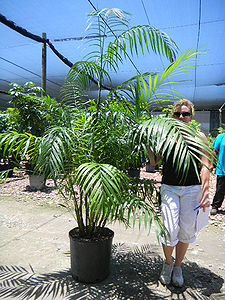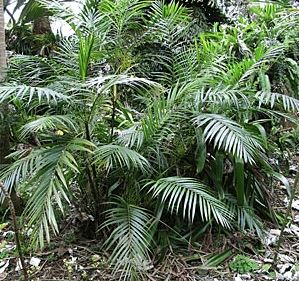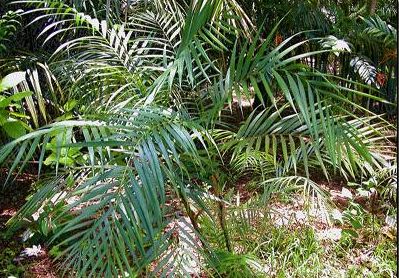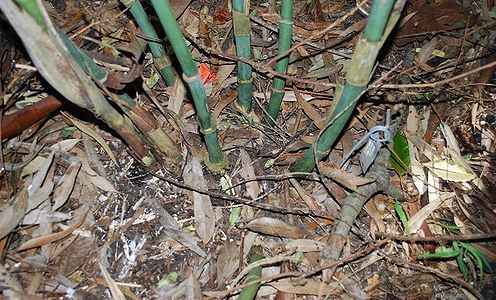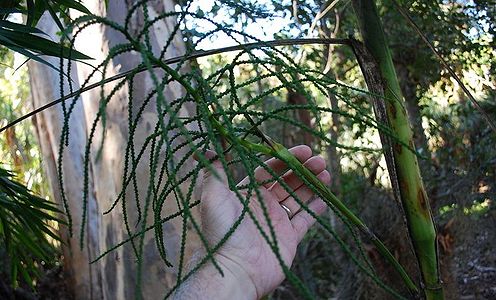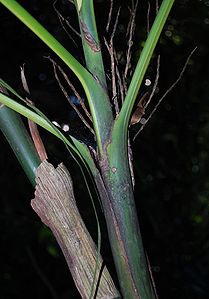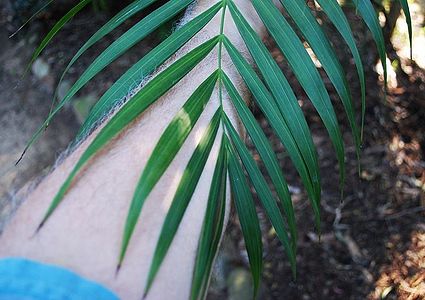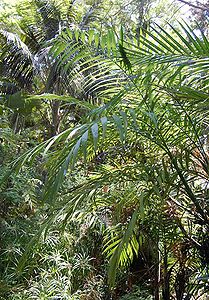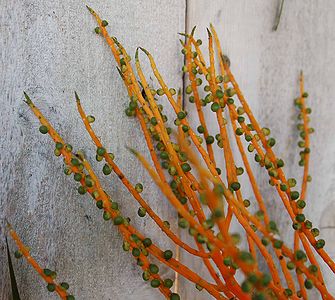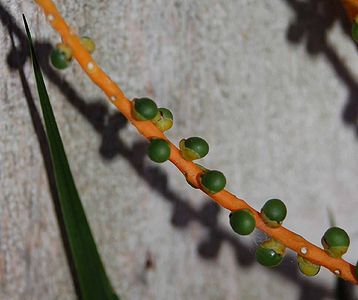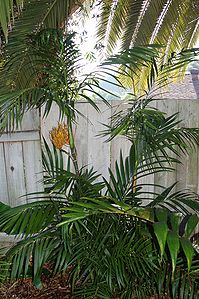Difference between revisions of "Chamaedorea hooperiana"
| Line 5: | Line 5: | ||
|image=Seeds_001.JPG | |image=Seeds_001.JPG | ||
|image_caption=Non-viable seeds. | |image_caption=Non-viable seeds. | ||
| − | |genus=Chamaedorea (kam-ee-DOR-ee- | + | |genus=Chamaedorea (kam-ee-DOR-ee-ah) |
| − | |species=hooperiana (hoo-per-ee- | + | |species=hooperiana (hoo-per-ee-AH-nah) |
|subspecies= | |subspecies= | ||
|cultivar= | |cultivar= | ||
Revision as of 06:09, 19 December 2012
<google>CH02</google>
| Chamaedorea (kam-ee-DOR-ee-ah) hooperiana (hoo-per-ee-AH-nah) | |||||||
|---|---|---|---|---|---|---|---|
 Non-viable seeds. | |||||||
| Scientific Classification | |||||||
| |||||||
| Synonyms | |||||||
|
| |||||||
| Native Continent | |||||||
|
| |||||||
| Morphology | |||||||
| |||||||
| Culture | |||||||
|
| |||||||
| Survivability index | |||||||
|
| |||||||
| Common names | |||||||
|
| |||||||
Contents
Habitat and Distribution
Rainforest of Veracruz Mexico. Dense, wet forest; alt. 1,000-1,500 m elevation.
Description
Trunk type: Clustering. Hight: To 4m (13'). Cluster spread: To 3m (10'). Leaf detail: Pinnately compound, diametrically opposed, somewhat widely spaced pinnae, erect new leafs, to become slightly drooping. Only recently discovered (by Don Hodel in 1992, during research for his definitive book on Chamaedoreas Chamaedorea Palms - The Species and Their Cultivation), this is said to be one of the most beautifull of the Chameadoreas. Tightly clustering species, with age, it can form a large group of slender, green stems that can reach 4 to 5 m (13 to 17 ft.) tall, each topped by a spreading crown of up to 7 flat, leathery, dark green leaves. It is a vigorous and very robust species that is easy to germinate and grow and more resistant than other clustering Chamaedorea to low humidity, mites and even light freezes due to its thick, leathery leaves.
Habit: Cepitose (growing in tufts or clumps), clustering, new lateral shoots emerging from tops of old dried persistent basal sheaths, forming fairly dense clumps to 3-4 m across, erect, leaning with age, to 4-5 m tall. Stems: 2-2.5 cm in diam., green, ringed, often covered with old leaf bases, internodes to 15 cm long. Leaves: 5-7 per crown, erect-spreading, pinnate; sheath to 40-50 cm long, tightly clasping, obliquely open apically and there splitting deeply opposite petiole with age, rough-brown-margined, below this whitish and longitudinally striate-nerved, old sheaths persistent, drying brown, hard, durable, ± woody; petiole to 20-35 cm long, lime-green and grooved especially near base above, rounded and pale below; rachis to 0.8-1 m long, sharply angled and lime-green above, rounded below with a green or yellowish band extending onto sheath, attenuate apically; pinnae 20-26 on each side of rachis, lower and middle ones longest, these to 40 x 1.8 cm, becoming progressively shorter.toward apex of rachis, regularly arranged, opposite to subopposite, flat off rachis, elongate-lanceolate, ± straight, only slightly falcate, long-acuminate, slightly contracted basally, ± thick, durable, a prominent pale midrib sharply angled above and 2 much less prominent primary nerves on each side of this, secondaries and tertiaries faint and inconspicuous, midrib prominent below, apical pair of pinnae slightly wider. Inflorescences: infrafoliar, emerging from tops of dried persistent sheaths, erect. Staminate with peduncle to 30 cm long, 1.5 cm wide at base, erect-spreading, pale.green where exposed; bracts 5-6, tubular, obliquely open apically and there bifid except largest which is long-acuminate and greatly exceeds peduncle and often conceals 1 or 2 smaller ones, longitudinally striate-nerved, brown in flower; rachis 20 cm long, light green; rachillae 40-45, these to 25 cm long, 1.75-2 mm in diam., spreading-drooping, light green. Pistillate with peduncle to 50 cm long, 1.5 cm wide at base, erect, pale or greenish in flower where exposed, reddish orange in fruit; bracts 6, similar to those of staminate inflorescence, brown and persistent in fruit; rachis to 22 cm long, green-yellow in flower, reddish orange in fruit; rachillae 40, lower ones longest, these to 22 cm long, apical ones to 10 cm long, spreading slightly, ± stiff, yellow-green in flower, reddish orange in fruit. Flowers: Staminate in moderately dense spirals, 3-3.5 mm distant, 3-3.5 x 3-4 mm, sub-globose, bright yellow, strongly aromatic, slightly sunken in elliptic depressions; calyx 1 x 2 mm, shallowly lobed, membranous, light green, sepals connate nearly to apex, broadly rounded apically; petals 3.5 x 3 mm, valvate, connate apically and basally and adnate apically to pistillode and corolla opening by lateral slits, perhaps petals later apically spreading slightly but remaining inwardly curved, broadly acute, margins ± thickened; stamens 2.5 mm tall, filaments 1-1.5 mm long, very pale green, nearly clear colored, anthers I mm long, yellow changing to white; pistillode 2.75 mm tall, columnar, light green, darkened and narrowed apically. Pistillate in rather remote spirals, 8 mm distant, 3 x 3 mm, globose, greenish yellow, slightly sunken in elliptic depressions; calyx 1-1.5 x 3 mm, prominently lobed, very light green or nearly yellow, sepals connate and or lightly imbricate briefly basally, broadly rounded apically; petals 2.5-2.75 x 3 mm, tightly imbricate nearly to apex, acute; pistil 3 x 3 mm, globose, light green, stigma lobes sessile, distinct but low, rounded. Fruits: 7-8 mm in diam., oblong-globose, black. Editing by edric. (Hodel, D.R. 1992)
C. hooperiana presently exists in only a few collections in southern California. Pauleen Sullivan in Ventura, Lou Hooper in La Habra, Jack Ingwersen in Oceanside, and the Huntington Botanical Gardens in San Marino have mature plants in their gardens. For years these plants were unidentified and their origin uncertain. The common story was that the existing plants originated from one introduction from Central America. However, the Huntington's plant may have originated from a different introduction. In December, 1989, during field work in Mexico, we found C. hooperiana in the wild in the Catemaco region of Veracruz, enabling us to provide a known locality for it. Sullivan has plants of both sexes and produces seeds regularly that she has distributed to local palm collectors and hobbyists. I originally thought that this species was C. karwinskyana and plants of C. hooperiana may have been distributed as such. However, I have since examined the type of C. karwinskyana and realize that it can be included with C. pochutlensis. Similar florally to C. graminifolia and vegatatively to C. pochutlensis, C. hooperiana can be distinguished in the manner in which It sends forth new shoots from the base of the plant. These emerge from the tops of the persistent, nearly woody, basal leaf sheaths. In addition, C. hooperiana has thicker, durable, nearly plastic like leaves. Rhizomatous stems emerging some distance from the parent plant and soft, thin, narrowly linear pinnae distinguish C. graminifolia. Other distinguishing characters of C. pochutlensis include the staminate flowers with apically spreading petals and broader, softer pinnae. A handsome species of easy culture, C. hooperiana is a vigorous and relatively fast grower. Its eventual size should be considered when placing it in the landscape. With age, it will form rather dense clumps several meters across. Stems toward the perimeter ofthe clump tend to lean outward gracefully, occupying even more space. It is more resistant to infestations of mites than C. costaricana and C. pochutlensis and is much superior as an indoor plant. In fact, it holds great promise for use in interior situations due to its tolerance of low light and low humidity and resistance to pests. Collectors in southern California have made hybrids between C. hooperiana and C. pochutlensis. (Hodel, D.R. 1992)
Culture
Requirements: Filtered light when young, partial shade when mature, consistently moist soil is best, but is somewhat drought tolerant, well drained position. Tolerating low light and neglect it is also a prime choice for indoors but it will perform best outdoors under some canopy in the warm temperate garden.
Comments and Curiosities
Chamaedorea are dioecious, male, and female flowers, on separate plants.
Etymology: Honors Louis Hooper of La Habra, California from whose garden the type originated.
Only recently discovered (by Don Hodel in 1992, during research for his definitive book on Chamaedoreas Chamaedorea Palms - The Species and Their Cultivation), this is said to be one of the most beautifull of the Chameadoreas. Tightly clustering species, originally known only from a few enthusiasts collections before being rediscovered in 1989 in montane rainforest in Veracruz, Mexico, was named in honor of master palm collector Louis Hooper of California.
External Links
References
Special thanks to Geoff Stein, (Palmbob) for his hundreds of photos, edric.
Special thanks to palmweb.org, Dr. John Dransfield, Dr. Bill Baker & team, for their volumes of information and photos, edric.
- IMAGE GALLERY
Many Special Thanks to Ed Vaile for his long hours of tireless editing and numerous contributions.


